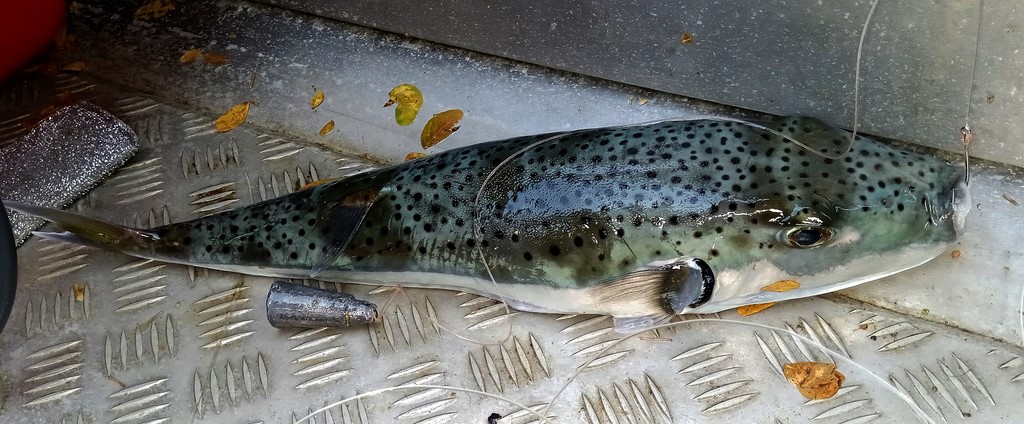LAGOCEPHALUS SCELERATUS - (GMELIN, 1789)
Actinopterygii (Gigaclass) > Actinopteri (Class) > Teleostei (Subclass) > Tetraodontiformes (Order) > Tetraodontoidei (Suborder) > Tetraodontidae (Family) > Lagocephalus (Genus)
Ballon à bande argentée, Silverstripe puffer, Silver toadfish, Giant toadfish, Giant toado, North-west blowfish, Silver pufferfish, Silver-checked toadfish, Silver-stripe pufferfish, Spotted rough-backed blowfish, Silwerstreep-blaasop, Sen-ninfugu, センニンフグ, 은띠복, 凶兔頭魨, 圓斑兔頭魨,
Synonymes
Fugu sceleratus (Gmelin, 1789)
Gastrophysis sceleratus (Gmelin, 1789)
Gastrophysus sceleratus (Gmelin, 1789)
Gastrophysus scleratus (Gmelin, 1789)
Lagocephalus scleratus (Gmelin, 1789)
Lagocephalus scleratus (Gmelin, 1789)
Pleudranacanthus sceleratus (Gmelin, 1789)
Pleuranacanthus sceleratus (Gmelin, 1789)
Spheroides sceleratus (Gmelin, 1789)
Sphoeroides sceleratus (Gmelin, 1789)
Sphoeroides scleratus (Gmelin, 1789)
Tetraodon bicolor (Brevoort, 1856)
Tetraodon blochii (Castelnau, 1861)
Tetraodon sceleratus (Gmelin, 1789)
Tetrodon argenteus (Lacepède, 1804)
Tetrodon sceleratus (Gmelin, 1789)
---------------------
Description
Dorsal soft rays (total): 10-13 (usually: 12); Anal soft rays: 8-12 (usually: 11); Pectoral fins rays: 16-17 (usually: 17); Body oblong; Longitudinal skin fold along ventrolateral part of body; Dorsal fin and anal fin pointed, the minute ray at origins of these fins usually hidden in skin; Caudal fin usually emarginate or truncate; Lower lateral line not apparent. Max. length: 110 cm TL, common length: 40.0 cm TL. Max. published weight: 9.0 kg. Depth range: 18 - 100 m.
Color
Upper body dark greenish grey, with moderately dense array of irregularly scattered black spots from snout to peduncle; Sides bluish grey, with broad silvery band from corner of mouth, becoming thinner below eyes, and then broadening and passing through pectoral fin bases, tapering along sides and ending at caudal fin base; Belly white or greyish white; Dorsal fin and pectoral fins dark greyish; Anal fin whitish; Caudal fin yellowish grey.
Etymology
Lagocephalus: from Greek, lagṓs = hare or coward + from Greek, -kephalos = head. Referring to powerful, hare-like incisor teeth of Lagocephalus stellatus and Lagocephalus pennantii.
sceleratus: from Latin, scelerātus = a criminal, a vicious, impious, wicked person. Referring to the extremely poisonous and potentially deadly fish if eaten by humans; Manuscript name coined by Johann Reinhold Forster (1729-1798), naturalist aboard Captain Cook’s second voyage on HMS Resolution, after he, his son, and Captain Cook ate a small portion of this puffer’s liver in New Caledonia and got very sick for three days.
Original description: Tetrodon sceleratus Gmelin, 1789 - Type locality: American (in error) and Pacific.
Ballon à bande argentée, Silverstripe puffer, Silver toadfish, Giant toadfish, Giant toado, North-west blowfish, Silver pufferfish, Silver-checked toadfish, Silver-stripe pufferfish, Spotted rough-backed blowfish, Silwerstreep-blaasop, Sen-ninfugu, センニンフグ, 은띠복, 凶兔頭魨, 圓斑兔頭魨,
Synonymes
Fugu sceleratus (Gmelin, 1789)
Gastrophysis sceleratus (Gmelin, 1789)
Gastrophysus sceleratus (Gmelin, 1789)
Gastrophysus scleratus (Gmelin, 1789)
Lagocephalus scleratus (Gmelin, 1789)
Lagocephalus scleratus (Gmelin, 1789)
Pleudranacanthus sceleratus (Gmelin, 1789)
Pleuranacanthus sceleratus (Gmelin, 1789)
Spheroides sceleratus (Gmelin, 1789)
Sphoeroides sceleratus (Gmelin, 1789)
Sphoeroides scleratus (Gmelin, 1789)
Tetraodon bicolor (Brevoort, 1856)
Tetraodon blochii (Castelnau, 1861)
Tetraodon sceleratus (Gmelin, 1789)
Tetrodon argenteus (Lacepède, 1804)
Tetrodon sceleratus (Gmelin, 1789)
---------------------
Description
Dorsal soft rays (total): 10-13 (usually: 12); Anal soft rays: 8-12 (usually: 11); Pectoral fins rays: 16-17 (usually: 17); Body oblong; Longitudinal skin fold along ventrolateral part of body; Dorsal fin and anal fin pointed, the minute ray at origins of these fins usually hidden in skin; Caudal fin usually emarginate or truncate; Lower lateral line not apparent. Max. length: 110 cm TL, common length: 40.0 cm TL. Max. published weight: 9.0 kg. Depth range: 18 - 100 m.
Color
Upper body dark greenish grey, with moderately dense array of irregularly scattered black spots from snout to peduncle; Sides bluish grey, with broad silvery band from corner of mouth, becoming thinner below eyes, and then broadening and passing through pectoral fin bases, tapering along sides and ending at caudal fin base; Belly white or greyish white; Dorsal fin and pectoral fins dark greyish; Anal fin whitish; Caudal fin yellowish grey.
Etymology
Lagocephalus: from Greek, lagṓs = hare or coward + from Greek, -kephalos = head. Referring to powerful, hare-like incisor teeth of Lagocephalus stellatus and Lagocephalus pennantii.
sceleratus: from Latin, scelerātus = a criminal, a vicious, impious, wicked person. Referring to the extremely poisonous and potentially deadly fish if eaten by humans; Manuscript name coined by Johann Reinhold Forster (1729-1798), naturalist aboard Captain Cook’s second voyage on HMS Resolution, after he, his son, and Captain Cook ate a small portion of this puffer’s liver in New Caledonia and got very sick for three days.
Original description: Tetrodon sceleratus Gmelin, 1789 - Type locality: American (in error) and Pacific.
Distribution
Red Sea and Indo-West Pacific: Eastern Cape and KwaZulu-Natal (South Africa), East Africa, Persian Gulf, Socotra (Yemen), Seychelles, Madagascar and western Mascarenes (La Réunion, Mauritius), east to Philippines, north to central Japan, south to Kimberley (Western Australia), Queensland (Australia) and New Caledonia; Mediterranean Sea and Sea of Marmara (Red Sea immigrant).
Biology
Inhabits offshore reefs. Sandy bottom. Caught by trammel net. Oviparous. This species contains tetrodotoxin which may be a source for food poisoning. Poisonous to eat.
Similar species
Lagocephalus suezensis (Clark & Gohar, 1953) - Reported from Red Sea and Indo-West Pacific: Myanmar, east to Indonesia, north to southern Japan, south to northern Australia; Mediterranean Sea (Red Sea immigrant).
Last update: 17, September 2024
Red Sea and Indo-West Pacific: Eastern Cape and KwaZulu-Natal (South Africa), East Africa, Persian Gulf, Socotra (Yemen), Seychelles, Madagascar and western Mascarenes (La Réunion, Mauritius), east to Philippines, north to central Japan, south to Kimberley (Western Australia), Queensland (Australia) and New Caledonia; Mediterranean Sea and Sea of Marmara (Red Sea immigrant).
Biology
Inhabits offshore reefs. Sandy bottom. Caught by trammel net. Oviparous. This species contains tetrodotoxin which may be a source for food poisoning. Poisonous to eat.
Similar species
Lagocephalus suezensis (Clark & Gohar, 1953) - Reported from Red Sea and Indo-West Pacific: Myanmar, east to Indonesia, north to southern Japan, south to northern Australia; Mediterranean Sea (Red Sea immigrant).
Last update: 17, September 2024
